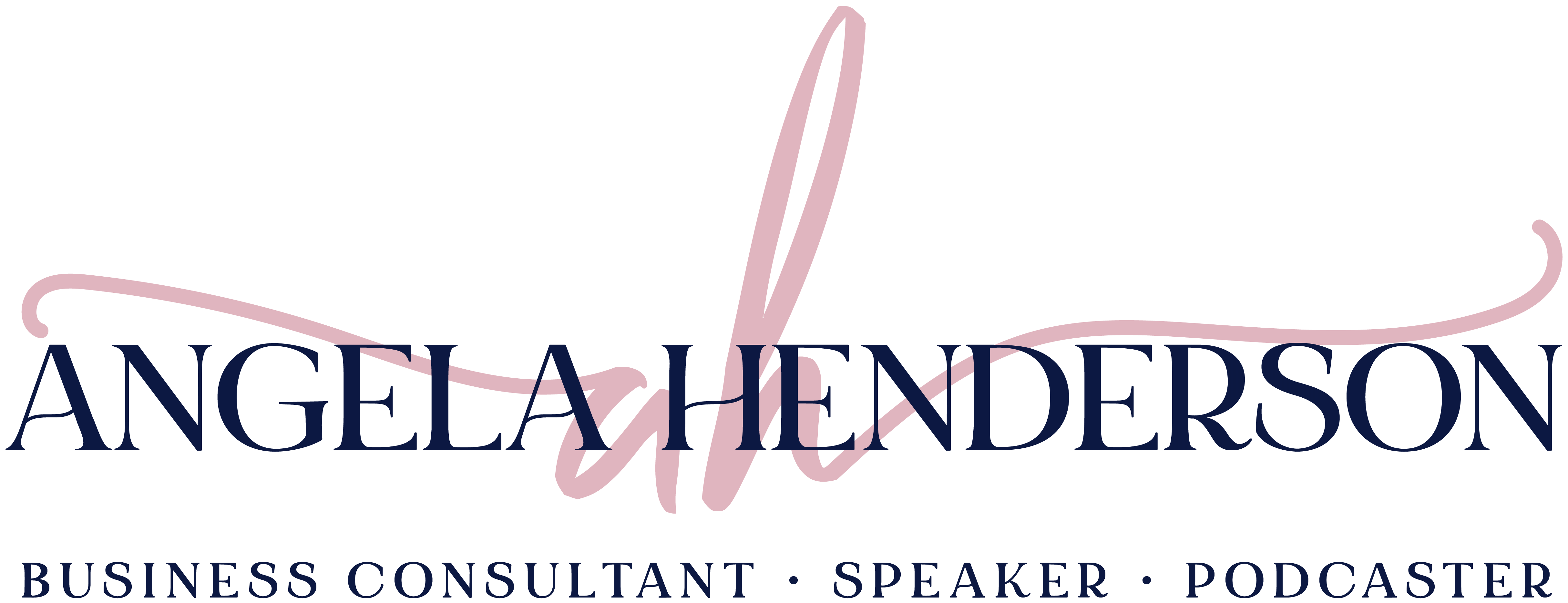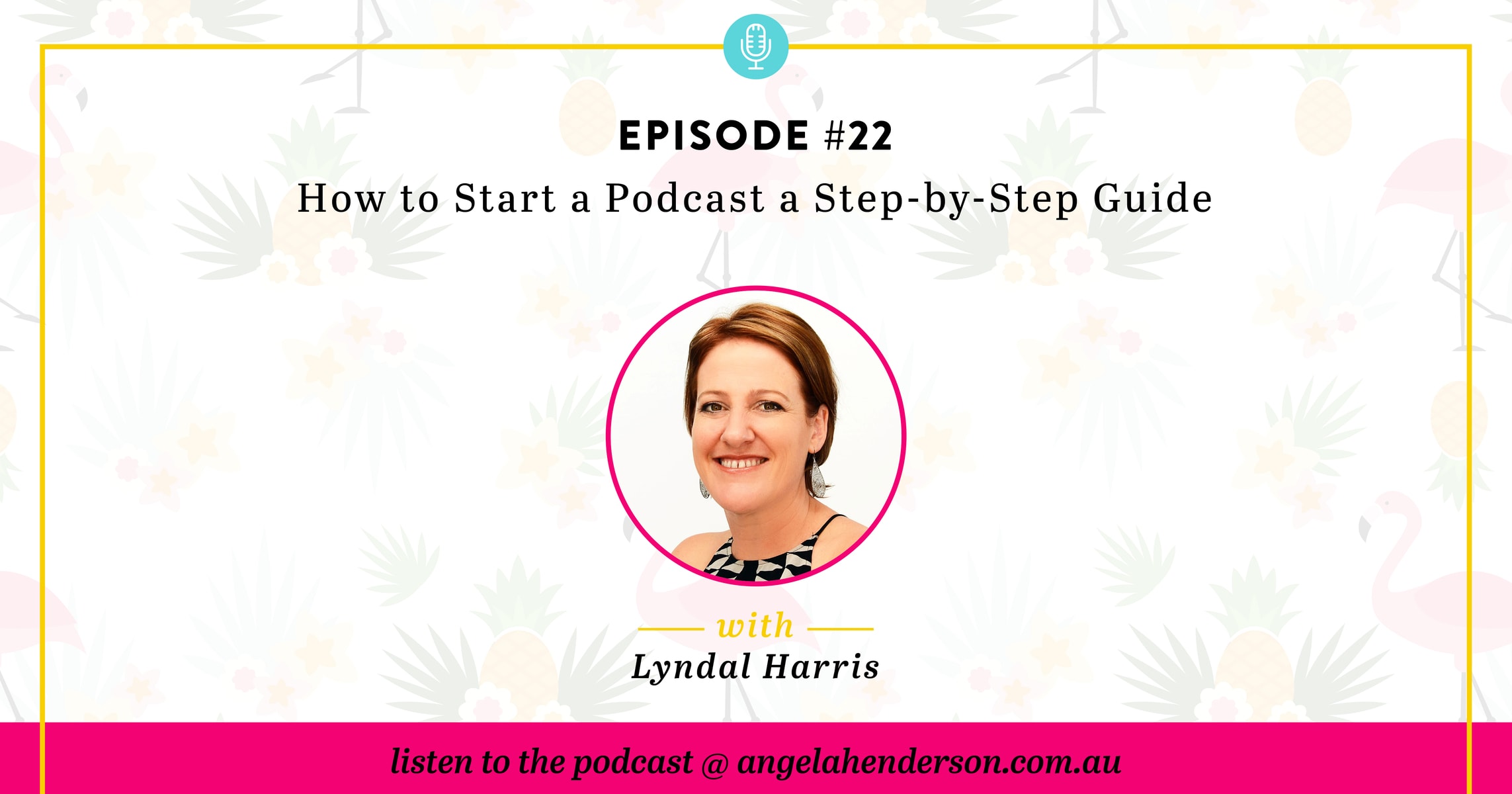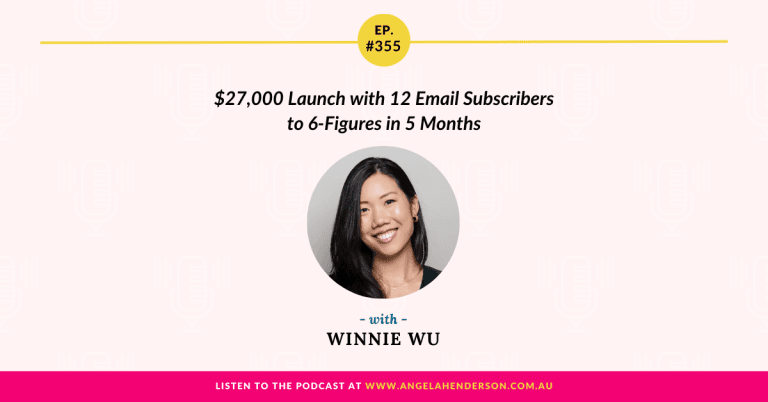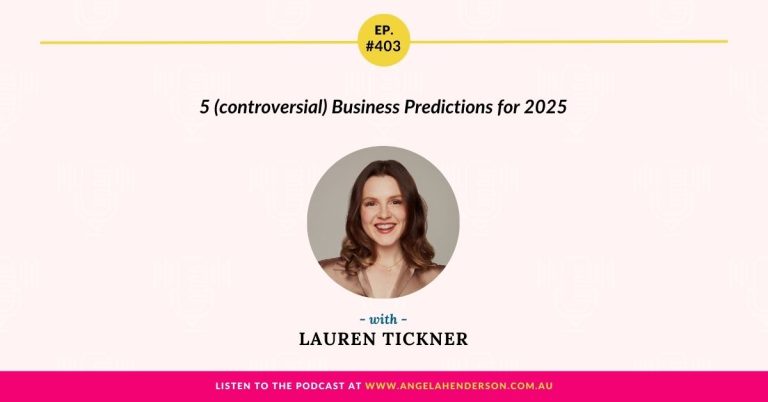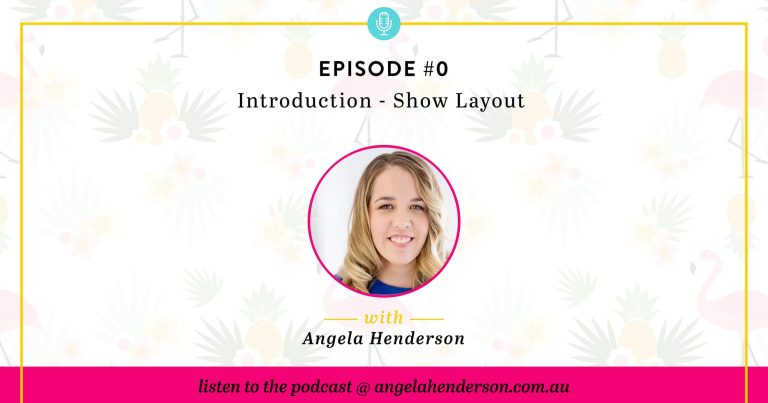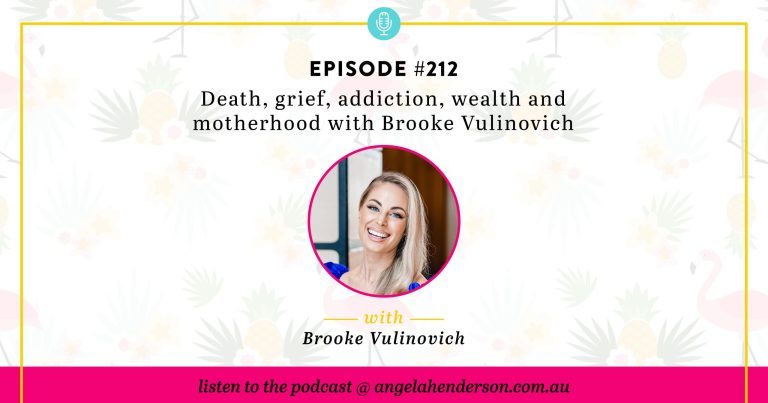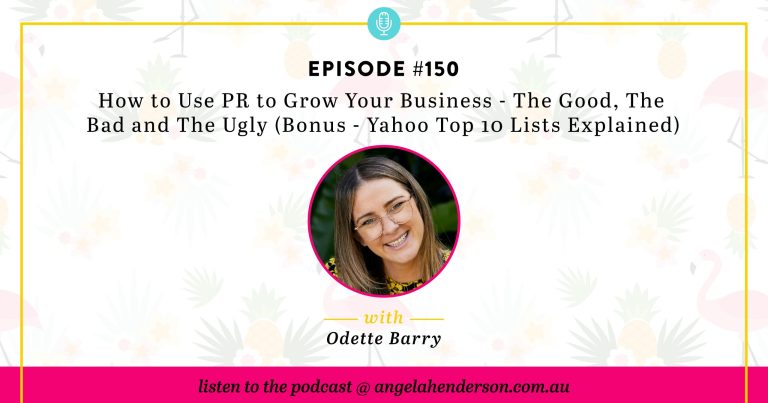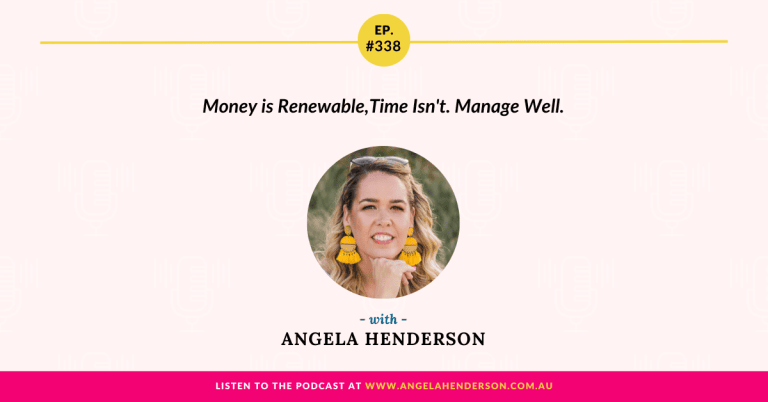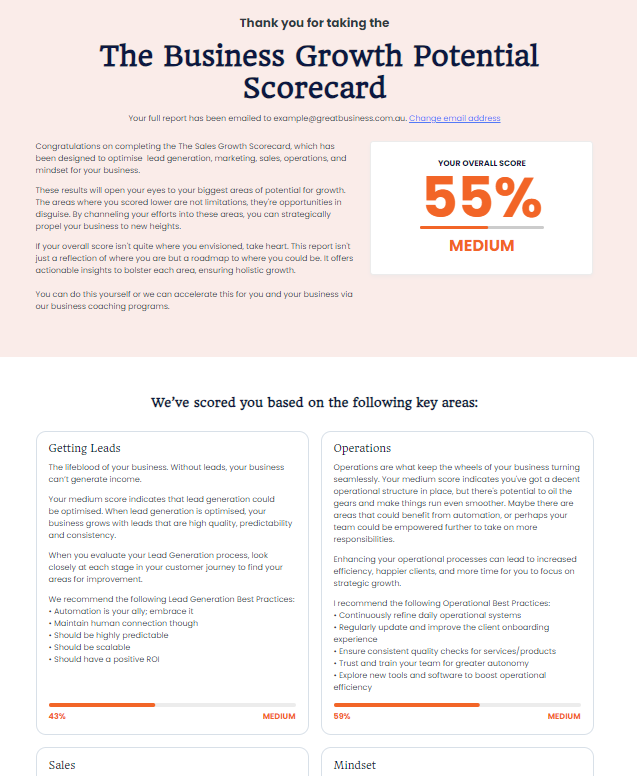If you’re looking to start your podcast or looking for ways to improve your existing one, definitely listen in because Lyndal Harris of Podcast VA joins us today as she shares her knowledge on why businesses should start a podcast and the several benefits of starting one for your business. She also walks us through her 10-step guide on starting your own podcast and gives us interesting tips on going about it.
Important Links Mentioned in the Show:
Australian Podcasters Collaborative Facebook Group
Angela Henderson Active Business Facebook Group
Angela Henderson Facebook Business Page
Prefer to read How to Start a Podcast a Step-by-Step Guide? Here’s the transcript:
ANGELA:
You’re listening to the Business and Life Conversations podcast, with Angela Henderson, episode 22.
Hey there, you’re listening to the Business and Life Conversations podcast, my name is Angela Henderson, and on this show we talk about improving your business, life or both. By having amazing and rich conversations with brilliant guests. Who will inspire you and who will give you tips and tricks, to help you grow both in life and in business.
Hello, hello amazing humans. It’s another episode of the Business and Life Conversations podcast with me, your host, Angela from Angela Henderson Consulting. Today is a great day, because today we get to talk about all levels of awesomeness. That’s right, awesomeness. And awesomeness, I mean podcasting.
Fist bump, fist bump because you can’t see me actually doing it. Every single week I have conversations with numerous people who are wanting to start their own podcast. They are confused and overwhelmed. They don’t know where to start, and thus, they put podcasting off into the too hard basket. When in reality it doesn’t need to be this case. I’m thrilled to have Lyndal from Podcast VA, on the show today, because she’s going to share with us why businesses should start a podcast, the benefits of starting a podcast for your business, and also she’s going to share with us how to start a podcast using her ten step by step guide for creating a podcast. Welcome to the show, Lyndal.
LYNDAL:
Thanks for having me, Ange.
ANGELA:
It is super exciting that we just hung out down last week in at Digital Marketing World. Is that right? Digital Marketing Down Under. I think. It was cool to hang out with you last weekend, and I’m super excited to have you on the show. Thanks for taking time out of your busy schedule to be here today.
LYNDAL:
You’re welcome.
ANGELA:
You and I, we’ve only been friends for a very, very short time, but in that time we have become good friends, but it’s also because of you that I actually got my podcast off the ground. As I mentioned earlier, a lot of times people are feeling that overwhelm, confusion, and not knowing what to do, and I was actually that person I described above. I don’t know what to do. I know I needed to do a podcast, because that’s what my customers, you could say, or my ideal client was asking for. But I was beyond overwhelmed with the how tos.
However I came across you, I think it was a group. I was trying to track back where you and I initially met, I believe it was in a group. And next, the rest is really history. I basically recorded my first episode. I sent everything to you, and you literally do everything for me from start to finish. I’m super grateful that I found Podcast VA with you, also may have never gotten my podcast off the ground. For clearly those that are listening, you may not have noticed, I’m slightly a huge fan of Lyndal, and her services. Because it’s because of her, as I said, the podcast Business and Life Conversations has gone to air. But enough about that, because I could talk about your awesomeness all day, but let’s get to know you a little bit more, Lyndal. Before we jump right into things, I always like to let people know a little fun side about you. Today, my question to you is, what’s your favourite pasta?
LYNDAL:
My favourite pasta? Big fan of spaghetti carbonara. But I don’t have it very often to be honest, but I do like it.
ANGELA:
Cheese, or no cheese?
LYNDAL:
Cheese. Absolutely. My husband doesn’t eat cheese. I just don’t understand people who don’t love cheese.
ANGELA:
Seriously. It’s like cheese, people. But no, I like to, it’s not all about business, I like to incorporate a bit of fun. Today, like I said, your question was your favourite pasta. We now know a bit more that you like carbonara. You don’t eat it often, but you do love a little of extra cheese. Good way to zoom in, start in on our podcasting episode. Why do you think, I could talk about it, but why do you think from a Podcast VA specialty, that businesses should start a podcast?
LYNDAL:
I think that businesses should consider a podcast as part of their marketing activities, because it’s the only form of content that you can consume, and multitask while you’re doing it. I think that is definitely one of the biggest draw cards for it. Obviously, video is massive at the moment as well, but you can’t … You can watch so much of a video and multitask, but if your phone locks, or if you want to change apps, then the video stops. At least with podcasting, you can listen to it while you’re driving, while you’re doing your chores, while you’re doing your exercise. And the stats show that a lot of people are multitasking while they’re listening to it.
ANGELA:
Yes, and I know there’s a lot of my people who listen to this podcast who said that they listened to it either driving to their … Doing part time, or full time job that’s an opportunity to still feel connected with their business, and learning things, even though a lot of them report back they’re going to work, they don’t want to be at work, they want to get the business going. Just being in the car on those ten, 15, even 45 minute commutes have been helpful to get their businesses still going or progressing, you could say without it being at a standstill.
LYNDAL:
Yes. Absolutely. And it’s just such a great, it’s a good way to give your audience as well a different way to consume it. You might do videos, you might give them a transcription to read as well, and it’s giving them the option of how they want to consume it. It’s great. Obviously, I love it. I’m a bit biased.
ANGELA:
Obviously people can want it, it’s easy to consume. They can be walking their dog, riding in a car, even on a plane. You can download episodes, etcetera. But what are the benefits though of a business particularly having a podcast?
LYNDAL:
Well, there’s lots of reasons why people do podcasting and the benefits to it. The stats are growing. Year on year. America is obviously the biggest place for podcasting, Australians are following that, were not quite as big, but we’re probably second in line to America. We can watch the trends that are happening there, and the stats here in Australia are showing lots of people have an understanding of what podcasts are now. We‘ve still got to educate them how to listen, and how to subscribe. But that’s definitely growing. It’s a growing platform, and I think knowing your objective of why you are going to do it. A lot of people will do it for brand awareness, to grow brand awareness … Can I just stop there?
ANGELA:
That’s all right.
LYNDAL:
I started answering the wrong question then.
ANGELA:
You’re the editor, we can really do what we want. Because you’re the one that’s going to stitch it together. I’m totally okay with it.
LYNDAL:
That’s what I figured, I was, you know what? That’s okay. I can do that.
ANGELA:
Do you want me to start back at … We’ve done the, why should businesses start a podcast? Do you want to go back to the benefits? Really reintroduce that question?
LYNDAL:
Yes, I just wanted to frame how I’m going to answer that, benefits of it. It’s consuming … Because why businesses shouldn’t I answered similarly to how I’d answers the benefits?
ANGELA:
Yes, what are the benefits? The benefits could be is that … I guess one could be that people can multitask. It doesn’t matter that you’re repeating yourself.
LYNDAL:
You got your multitask, you’ve got your subscription so that people catch them all.
ANGELA:
The other benefit is it helps to increase brand awareness. For those that are trying to get their business out, it’s another way to for people to consume information. I guess is … increase brand awareness, you can multitask. It also can help … you could say with SEO. If you put that transcription onto the … so it’s not just them listening to the file, or the … off of iTunes, that it’s people who have a podcast do it well, and the SEO optimise their content on their website that also could be helpful to help them be found organically you could talk about.
LYNDAL:
And repurposing, yes. Sorry, my head just flipped out of it, because I answered it the other way round.
ANGELA:
We’ve already done the, why should businesses start a podcast, and then again, we will then go into, what are the benefits of having a podcast.
Can you talk us through a little about what your thoughts are? I know there’s multiple benefits for having a podcast for your business, but what do you think are some key reasons why businesses can benefit from having a podcast?
LYNDAL:
I think that the biggest benefit of it is increasing brand awareness, but we just be mindful of the fact that places like iTunes, and Stitcher radio and Spotify are really busy marketplaces of podcasts now. You have to know your purpose, and your goal, and be really clear on that. But it can be a really good starting point for repurposing your content.
Whether you repurpose your content into a podcast, or whether you repurpose your content out of a podcast, there’s lots of ways that you can make that work really well in your content marketing circle. The SEO benefits of having a podcast as well. You can … Like you do, you transcribe your episodes, which gives you lots of … There’s some, the things you can do in the backend with your audio file, and things like that for your SEO, but also when it comes to your website, there’s obviously the things that you can do on your blog posts to help with your SEO as well.
ANGELA:
No, I totally agree. Because, SEO is so important to be found from an organic nature, but just pushing people … That push, pull marketing, just pushing people always to things. I think it’s an enormous benefit, the SEO side of things. Obviously, it takes a little while for Google to crawl things, but eventually there can be huge benefit if you optimise it correctly, like we’re doing with this particular podcast. The other benefit I would say too, is that, I don’t know about you, but my thoughts are, is that for people who might not be ready to buy yet, or they’re still in that, “I think I want to buy from you, Angela.” “I want to think, I want to buy from you Lyndal.”
Is that there’s an opportunity to showcase your credibility, and authority to those people. You can warm them, you can build that relationship, you can nurture the relationship. And by doing that you’re building your credibility and authority, which helps to potentially make someone a customer long term. I think that it’s an ongoing benefit of having a podcast for a business.
LYNDAL:
And it just builds that relationship in a really intimate way that you can’t do … You can get some of that through video, but obviously just say, they’re listening more. The other benefit is that people can subscribe to your podcasts as opposed to just listening to some audio that’s not a podcast as such, they subscribe, and then they get every episode delivered to their pod catcher. Every time you release an episode they’re getting it. That personal relationship, and the relationship building is really a key benefit as well.
ANGELA:
I think it is important to talk about that from a subscription point of view is, because you … I can still post my podcast on Facebook, but it will depend if the algorithm’s going to show people that my podcast … Because I’ve obviously gone in there, and put the link from the website, and shared from a repurposing point of view. But it doesn’t mean that Facebook’s going to show that to the fans of my page. Whereas when they are on iTunes, and it’s actually they’ve subscribed to it, they’re going to get that update every single week, or every single time I release an episode. I’m not dependent on those social media platforms to get my content out to my people.
LYNDAL:
Yes. Absolutely. And whatever pod catcher they use, whether it be the … When I say pod catcher, pod catcher is simply the name of the app that you listen to it through. A lot of people are listening through Apple devices, or Apple podcasts app. A lot of people are also moving away from that. Google podcasts have recently, launched their app to go on all the android devices. You have Stitcher radio, you have lots of different … There’s Pocket Cast, and Castbox and Spotify. To be able to subscribe in any of those pod catchers, and have it delivered there, a lot of people, if they’re on their commute to work, they’re listening to a podcast on their way to work, on the train, or on the bus, or even driving, they like that it’s delivered to their device at that time, and they know they can then listen to it.
ANGELA:
No, I totally agree with that. It’s just one more thing, because people in the world we live in are becoming lazier and lazier. You have to tell them to do something. When iTunes releases it, and tells them, “Hey, this is ready for you.” All they have to do is click one button versus going searching for it, going doing this, blah, blah blah. It’s a huge benefit to being able to have that subscription there. Obviously, people out there, might be listening, going, “Okay, this all sounds great, but I’m really only listening, because I want to know the top ten steps of trying to start, how to start a podcast.” Can you walk me through the top ten steps that people need to be thinking about to start their podcast?
LYNDAL:
Yes, sure. Step number one is definitely knowing your purpose. Be really clear with your planning about why you’re doing a podcast. What problem are you solving, or what information are you sharing with your listeners? Who are your listeners? Working out your format? Are you going to do solo shows? Are you going to do interviews? Are you going to have a mix of both? Are you going to be weekly, or fortnightly, or monthly? And just nailing all of that before you even start to think about what equipment, or what software do you use to do that. I think there’s some key steps that come in before the equipment, which is where a lot of people start at, what microphone should I use? Step one is, really know your purpose, and know how it’s going to filter. With podcasts, you’ve got two types of podcasts.
You have an entertainment style podcast, and you have a business style podcast. If we’re talking business style, then you want to make sure that it’s going to funnel into your business activities, otherwise it’s a lot of work for something that just sits on the side, and you’re not funneling it into something.
ANGELA:
Gosh, I couldn’t … There’s so many podcasts that I see … But if you’re … Like for us, we’ll be on here for 45 minutes. It’s 45 minutes of your time, then you’ve got to edit, I’m just thinking, yes, you need to … Step one is really think about the purpose, or, AKA, the strategy behind why you’re having a podcast. And I also make sure that, I would recommend one more thing within that, creating your strategies. Do your current ideal clients want to consume information by auditory? And if you haven’t, go and survey them, and make sure that they’re actually going to be listening. Because if the majority of your audience is rather, they’re blog readers, then don’t go and create a podcast. Because you’re actually going to be missing your ideal client mark. In that strategy, really flesh out, if your listeners, or your fans, or your customers, whatever you want to call them, want … Want a podcast from you.
LYNDAL:
Yes. Definitely, not everybody’s into podcasts. That’s important.
ANGELA:
Like you said, some people we’re still educating the Australian market about podcasts, what to do, where you find them? It’s really important to make sure you do that extra step to make sure that they want that. All right, step two, what’s step two for how to create a podcast?
LYNDAL:
Step two is about looking at your podcast title, and creating a tagline. It’s really easy to get hung up on the name of your podcast, but just choosing a name that I think sometimes the really quirky names can get lost a little bit. It depends on what your podcast is about, but choose a name, and choose a tagline that’s quite short, but explains what your show is about.
ANGELA:
Yes. And I’m the one that was like, “What should I name this, this is crazy.” Then I was, you go and start looking at all these podcasts, and then you’re overwhelmed, where I think again … Sometimes it’s about just keeping it simple. Mine, Business and Life Conversations. It wasn’t really complex. I made it bigger than Ben Hur, but I didn’t have to do that. I agree with you, just choose really simple. I think I agree with you, sometimes those quirky names … The quirky names sounds really cool, but then I’ve got to work hard to trigger, try, and figure out what they’re actually podcasting about. That then I get fed up, and I don’t even go and listen to it. Sometimes quirkiness can have a detriment to what you’re trying to achieve.
LYNDAL:
Absolutely. And just make sure if you’re going to go quirky, you have a very clear tagline.
ANGELA:
Perfect, and I love it. What’s the third step in how to create a good podcast?
LYNDAL:
Step three is about thinking about the branding of your podcast. The cover art that you’re going to use, you have to be very specific in your dimensions, with the cover art. And you’ve got to remember that when you’re looking at cover art on a screen, 1400 by 1400 is actually quite a large image. But when you’re looking at it on a device, on a mobile phone, for example, it’s a tiny image. You want it to pop out, use some colours to make it stand out. Don’t put too many words on it, because the words will have to be quite small, you can’t read them anyway. Make sure you get those dimensions correct. There’s that as well as part of that branding, is the music that you use for your intros and outros.
Because, the music … I’ve listened to many podcasts where there’s a massive disconnect to the music that it just, it’s confusing. It confuses the audience, and it’s just, you want it to align. Particularly when you’re talking about a business podcast to your current branding.
ANGELA:
You would say then, if we just recap, step one, create a strategy. Step two, create your podcast title. Step three, we want to create really cool cover art. That isn’t too wordy. Pops a little, and then you could also say that, were blending into step four, which is around creating the intro and outro, and making sure that it’s congruent with your overall brand, your overall feel. So that people are wanting to listen without feeling disconnected as soon as they hear that punchline, right?
LYNDAL:
Yes. I think actually going … If the step here is, don’t forget to write a good podcast description. Which you could probably put up with the title, and the tagline. Going in before we talk about the intro and outro podcast description, make sure you weave your keywords in there. Know some keywords, weave it in there, and don’t make it too long. Because people don’t spend a lot of time reading them, but they want to know what your show is about.
ANGELA:
I’m wondering, because I think we’re confusing people. I think we did well with the strategy. We did well at that. Then we started the cover art was good, but then the way I read it, is that you then started talking about music, and the intro and outro. And we had skipped that podcast description. Then that where we recap, I reckon if we …
LYNDAL:
We go back to the step … Recap, and step down to cover art. I probably should change the order of that and put the description up with cover art. Actually.
ANGELA:
We’ve done … What I might do. Should I end it? Do you think? Or you’ll just be able to edit it. Or do you think What should we do?
LYNDAL:
That’s all right. Where are we at with time? Just write a timestamp down.
ANGELA:
No, I’m fine with time, as long as I just leave to get the kids. The time’s fine, should we do, create the cover art again, or do think we are fine with the cover art, and then I …
LYNDAL:
Cover art was good, just ask me what step four is before you recap, and then we’ll go into step five, which is intro, outro. We did cover art, even though I mentioned music, I did that as part of the branding.
ANGELA:
Okay. Yes, cool. Then I’ll just go, great step forward. Do you want me to do that? Yes, do you want me to recap. Step one, create a strategy. Step two, choose a podcast title. Step three, create the cover podcast. Now, what’s step four? Do you want me to do that?
LYNDAL:
Yes.
ANGELA:
For those that are out there, and you’ve got your pen to paper. We have obviously, step one, we’re creating a strategy, and our purpose. Step two, we’re choosing a podcast title, and creating a tagline. Step three we are creating the cover art for your wonderful podcast. And then Lyndal, what is step four?
LYNDAL:
Step four is writing your podcast description. Understanding how it all comes together, and then writing a really clear description that weaves your keywords in there. You don’t need to make it too long, but that description will be what shows in your hosting account. It’ll show in Apple podcasts, Google podcast, Stitcher. So you’ll use that everywhere. Just craft a couple of paragraphs that are really descriptive of what your podcast is about, and who it’s for.
ANGELA:
Would you also say; is there any benefit in iTunes, or Stitcher, or Google, or all that, to include keywords from an SEO point of view that you wanted? For example, mine is Business and Live Conversations with Angela Henderson. I made sure that I wanted to use the word business in there. Is there any benefit to include keywords?
LYNDAL:
Yes, definitely. You definitely want to keep the keywords in there, because people are starting to … There’s a couple of reasons, people are starting, they’ll search in iTunes, for example, and other pod catchers. You want to have those categories set up in your keywords as well. But also now with Google podcasts coming on, the SEO benefits of Google podcasts reading your podcasts, and picking it up, is that they will see the descriptions, and the show notes and there’ll be a play button directly from Google to actually play your podcast. When you’re writing anything, whether it be show notes, or description, keep keywords in mind and weave them in there.
ANGELA:
All right, perfect. Then what do these beasts who want to get their podcasts live need to do next? Step five.
LYNDAL:
Step five is creating your intro and outro. We touched on the music a little earlier, making sure that it aligns with the brand, and aligns with your personality. That’s really important to do that. I have had clients who have chosen music that is disconnected from the podcast that it just doesn’t flow properly.
Do that with your intros and outros. The trend a few years ago was to get voiceover artists to record it, but if you’re a solo podcaster, now it seems to be more popular to record your own. Keep it short. Keep your intro really short. People are moving away, or skipping through. If you’ve got longer intros. If your intro’s anything 20, to 25 seconds plus, it’s probably too long. You want to look at how you can cut that back, and stop people skipping through it.
And your outro, it can actually be a little bit longer, but make sure you have call to action. I would say one, maybe two, call to actions in your outro. Not any more than that. You don’t want it to be saying that, “Go to the website, go to all these social channels. Download our opt in. Subscribe on iTunes.” You want to have one to two really clear call to actions at the end in your outro.
ANGELA:
And for those individuals that do want to have a voiceover, because maybe there’s a couple of them that are doing the podcast together, where can they find both voiceover artists that are relatively inexpensive, but still get the job done.
LYNDAL:
I think I’ve got clients that have used Fiverr, and have successfully found people there, and you just want to keep things in mind. Do you mind if they’ve got a different accent to you? Because obviously there’s people well who do it with American accents. If you’re an Australian podcaster, you might not want to have those differences. Just be mindful of that. Fiverr is a good place to start, but there’s also a few voiceover agencies here in Australia that you can use.
ANGELA:
Fantastic. And then step number six, is obviously from what I understand is we need to start looking at choosing and recording the platform, and the device. Can you walk us through step six?
LYNDAL:
Yes, this is where you start to look at what software are you using? What microphone do you want to use? You’ve got to be mindful of the space that you’re going to record in. That’s first and foremost, before you go and buy a microphone, think about, am I in a room that’s got high ceilings, tiles, lots of glass windows, and doors? And it’s going to have lots of reverb that will be sounding echoey in your audio. Think about that. Then go and speak to somebody about what equipment should you use, and what would be best in this situation. If you’re going to be doing podcast interviews face to face, out on set, in different places, or at different shows, then your equipment is going to be very different to somebody who’s doing a solo show or a video repurpose, or doing a Zoom call.
Be mindful of that. Do some research and work out the best place. If you’ve got as far as the software that you’re going to record into, if you’ve got a PC, you might want to look at a free piece of software called Audacity. If you’ve got a Mac then, it comes with an audio software that you can use called Garage Band.
ANGELA:
Okay, perfect. And those don’t cost anything extra to people, or they could they also use Skype, or Zoom?
LYNDAL:
They can. I would suggest that the Audacity, and the Garage Band is a good place to record your intros and Outros, or episode intro. Anything that solo, and then when it comes to your interviews, you can use Skype. Skype actually have just in the last month, or so, released an inbuilt recorder. You could use Zoom. A lot of podcasters are using Zoom. That seems to be quite popular now. Sometimes the sound can be a little tinny, I guess it’s probably the best word for it in Zoom, but it’s still produces a good quality sound. And then there are others like Zencaster that people use as well. But it’s really about finding what works for you, and using that.
ANGELA:
Yes, Fantastic. Then what we’re going into step seven, what’s step seven?
LYNDAL:
Step seven I often say to people is, download a program called Auphonic. That’s A-U-P-H-O-N-I-C, it’s a post-production tool that you can set up a preset, and it will run each time you’ve edited it, or cut an episode together. You run it through that, and it will get it to the right levels for podcasts, it will get the right bit rate. You can tag it with your ID3 tagging, which is really important. ID3 tagging is actually what helps your podcast SEO from the audio file side of things. And just to expand on that a little bit and explain what it is, is when you think about how you have a music file in Spotify, or Apple music, it’s the, you’ve got the song name, you’ve got the album it comes from, the year, the artist. When you’re looking at a podcast or audio file, it’s the same thing. The artists, you put the podcast name, you put the podcast title as the album. What year it was released, it’s adding all of that information, and Auphonics will do all that plus give your audio a nice polished finish.
ANGELA:
All right, fantastic. Is there any costs of that particular element?
LYNDAL:
You can have up to two hours per month free on Auphonics. If you do, do a weekly hour show then you might need to purchase their lower level, but it’s really reasonable pricing just to … Particularly if you’re editing your own, and you just want to put it through, and make sure that you’re running it through processes that make it sound quite professional is worth buying the lower plan above the free one.
ANGELA:
Okay. And then obviously the podcast has to sit somewhere. It’s got to be hosted somewhere. With step eight, can you talk to us a little bit about hosting?
LYNDAL:
Step eight is, creating a hosting account. With a podcast, you actually don’t ever want to host it on your website. Because that will really quickly slow your website down, and make it quite clunky, which obviously for a lot of reasons, that’s not what you want to be doing. You create a hosting account where it’s, you put your audio, and every time you release an episode, you … Initially you set up your account, and you link it … It provides you with an RSS feed. Link that to Apple podcasts, Spotify, Stitcher radio, and every time you release an episode, you put it into your host, and it then pushes out to all of the various directories where you’ve put it. There’s a couple of great hosts. There’s three that I usually recommend.
There’s two Australian hosts, one is called Whooshkaa. Which is W-H-O-O-S-H-K-A-A. They provide a free hosting platform for solo podcasters, and with a lot of times we think, if it’s free, we’ve got to be wary. And certainly, in the podcasting space, that is the case a lot of the time. But Whooshkaa have some really major clients, some really major networks, and podcasters on their books. And so they monetise through them, and at this stage they still offer a free service for solo podcasters. If you have a great successful podcast, they will come to talk to you. They’ll never do it without talking to you. They will come to talk to you about whether you’d put some advertising in. Whooshkaa is a great one. Omnistudio is another brilliant one. They’re Australian. They started about nine U.S. dollars a month for … Basically for the level that most people will, or most podcasters would sit at.
On their website. You can’t actually say that they offer solo podcast packages, but if you contact them they can. And then of course the big player in the podcast world is Libsyn, which is an American company. Libsyn are fantastic. If I’ve got Australian clients, I tend to push them towards the Australian hosts, and if I had overseas clients I’d look at other hosts. And Libsyn is the main one I use then.
ANGELA:
What I like about Whooshkaa, for those people, it is free. That’s one we use here for the Business and Life Conversations podcast, but again, it’s been fantastic. I can log in, I can see my data about how many people have listened, which episodes are the most popular, what device people are … It’s kind of like Google analytics all in one too. That you’ve got everything there to be able to reflect, and see what your audience is enjoying, what they’re not enjoying, what you can do more of. I’m a huge fan of Whooshkaa, obviously I’m only at episode … Well, today is episode 22, so it’s not like I’m a pro at this, or anything, but it’s been an excellent platform so far for me.
LYNDAL:
It is, and it’s really fantastic. Their support is second to none. I have met the guys who work at Whooshkaa, I’ve met with … They get back to you straightaway if you’ve got questions, and they’re always happy to help. It’s fantastic, and as I say, Libsyn is the big player. One thing when you’re choosing a host is to consider, if you do have a big podcast, you have a really big audience, and you do want to monetise it down the track. I have spoken to somebody who said that they are an Australian podcaster, and they’re with Libsyn, and they just had to be mindful of the fact that the ads, that might’ve got Libsyn to help them with, would go to an American audience. That’s not necessarily a problem for everyone, but it’s just something to be mindful of.
ANGELA:
No, that’s fair enough. Obviously, we’ve got the hosting, we’ve got the Intros, we’ve got the podcast description, but number nine, we’ve got to submit our podcasts somewhere. Walk us through that.
LYNDAL:
You do. As we mentioned before, you get the RSS feed, and then once you’ve put two, to three … Usually I would say launch with two to three episodes anyway, but once you’ve got an episode live in your hosting account, you then can go and submit that RSS feed to Apple podcasts. Formally in iTunes, that’s quite a simple process of going in, validating your RSS feed and submitting it. That’s a two-step process. Most people get it right, but some people only validate it, and think it’s happened. It’s validate and submit. Google podcast, you don’t have to do anything differently at the moment. They’re pulling that automatically, you don’t need to go and submit to them. Stitcher radio was the big player. I think it’s still important to put it there, but it’ll be Interesting to watch this space now that Google podcasts have launched.
That will be an interesting transition for Stitcher, I think. And Spotify is another one that you want to put it to. Spotify is a lot more … What’s the word? I’m just going to edit this bit out. Let me go back. Spotify is having more success with entertainment style podcasts rather than business podcasts. It’s not to say don’t put it there, but the entertainment style, if you’ve got an entertainment style, definitely jump onto Spotify. But I just realise that Spotify takes a lot longer to approve the process of being on there. When you go to launch a podcast, just getting it onto Apple podcast and Stitcher radio is great, and then Spotify will happen sometime after that.
ANGELA:
No, fantastic. Because again, you get, I’m all about, just a few good things right from the beginning, and then look at growing. Again, do your Apple podcast, Stitcher, and then do those other ones after. Now listen, step ten, something that I think so many people, including in blogging, anything that it comes to content marketing collectively, people do very poorly, and then they complain, and moan that, I’m putting all this time into blogs, and I’m putting all this time into podcasts and blah, blah, blah, but it’s not getting anywhere. It’s not getting any traction. But again, I go, there’s a saying, you can point a finger at someone, and there’s three fingers pointing back at you. You’ve got to play an active role in distributing your podcast. So, step ten, share with us what people need to be doing in a very proactive manner.
LYNDAL:
Step ten is posting a podcast onto your website, and sharing it on social media and absolutely sharing it everywhere. Putting it on your website is really important. There are a lot of podcasters who just put, not a lot, I shouldn’t say that. But there are still podcasters who will upload their audio, and put it onto their host. Then share either the hosting link out or just share an iTunes link, which is a big, big mistake. Sharing an iTunes link, I can’t stress it enough, is a really bad strategy. Because anybody who’s not on an Apple device gets turned off straightaway, because you haven’t considered them. They can get their back up, they don’t necessarily, but they can get their back up. Put it onto your website. Put buttons where people can go, and listen.
Through Apple, and through Stitcher, and other places, but always put it onto your website with an embedded audio player. That URL, and the show notes on that page. And that URL is what you’re going to share out to your audience when you share it on social media. And when you share it through social media … Each week you can either send out an email when you’ve released an episode, or you could send out each month, you could send out a summary email. But put it into your email marketing so your audience know it’s there. But then when you start to look at sharing it on social, really make sure you promoting it more than once.
Because if 1% of people are seeing your Facebook page, and you only put it onto your Facebook page the day it’s released, no one’s seeing it there. Make sure you’re putting it onto your social, two, three, four, times after it’s been released. And if it’s evergreen content, use a program like Social Bee, or Meet Edgar, and put it in there, and then make sure that you’re pushing it out of the archives once you’ve already promoted it in the interim period.
ANGELA:
Yes. Even for myself, I’m getting in that habit of everything it goes on LinkedIn, Instagram, Facebook, my Facebook groups, etcetera, but it’s a constant reminder that only depending on the algorithms, it’s only gonna be seen by a very few amount of people. It’s our responsibility that in order for this to be successful, it comes back to us always constantly marketing, and repurposing, and getting it out there.
LYNDAL:
Yes, definitely, and it’s important that, that promotion of your podcast is critical to discoverability, getting it out there, and it’s quite incredible how many people don’t do that part of it very well. They get all of … They spend all that time in the pre-planning, and the planning, and the publishing, and getting it all ready to go, and then falling over at the promotion stage. It’s really important to get yourself a strategy. Just outline exactly what you’re going to do with each podcast episode, and just make sure that gets done, every single time you release.
ANGELA:
Spot on. There are a lot of amazing tips here, and probably your pen couldn’t write as fast as you could keep up with Canadian and the Australian speaking. But we will have everything listed on www.angelahenderson.com.au we will pull the whole transcription together for you guys. So don’t worry about that, Lyndal can also potentially include a link back to her website where you can download the free checklist, if you guys want to have a tangible copy of that particular checklist. That you guys can have that sitting by your desk where you can walk through those steps, so you’ve got them.
But yes, for those listeners out there, that one to have a stab at getting everything up and going, or would like to read some of your beautiful blog content, or for those, such as myself, who just said, “Listen, I don’t got time to try and figure out how to do podcasting. I just need to create the audio and give it to someone.” Such as yourself, Lyndal. Where can people find you so they can start to tap into your wisdom?
LYNDAL:
I have a website that has contact buttons on it to book in, do a free 30 minute consultation. So that’s www.podcastva.com I also am active on Facebook and Instagram, you can find it @PodcastVA and LinkedIn as well is Lyndal Harris. And I have a Facebook group, The Australian Podcasters Collaborative which I would love you to come and join. If you are interested, you don’t need to be podcasting if you’re just thinking about launching a podcast, jump in there and come and network with the people in that group.
ANGELA:
It’s a great group, it’s a wonderful community. There’s a range of us from beginners to those who are kind of gurus, super helpful, great tips especially if you’re kind of on that fence about, “What do I need to do?” so a wonderful platform to be able to ask those questions.
Well, thank you do much for joining me today, Lyndal. I hope for all of you, those of you who are out there and eager to start your own podcast that this particular podcast and how to create a podcast has been helpful for you guys. And as I mentioned before, my team and I will also be putting together the whole transcription for this episode at www.angelahenderson.com.au and of course, I cover all sorts of business related and life topics in my Facebook group, The Australian Business Collaborative.
Don’t get that confused with Lyndal’s Australian Podcast Collaborative, or heck just join both of ours because we are both awesome. Alright, and I’d love for you guys to join us over there in that community.
Until then, have an awesome day no matter where you are in the world and I look forward to connecting with you soon. This is Ange from Angela Henderson Consulting, have an awesome day!
Thanks for listening to the Business and Life Conversations podcast with Angela Henderson, How to Start a Podcast. www.angelahenderson.com.au.
